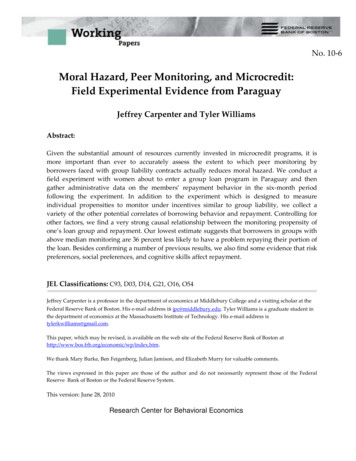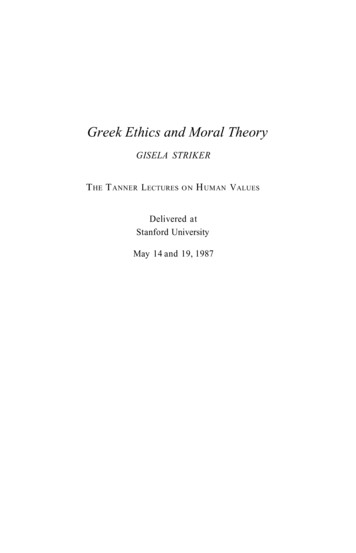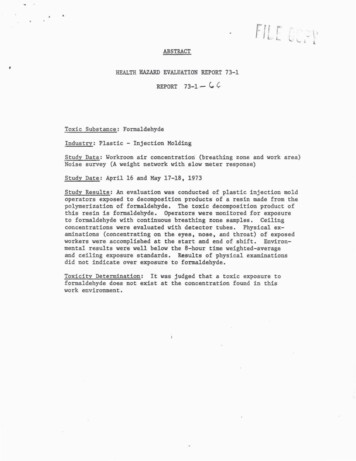
Transcription
No. 10-6Moral Hazard, Peer Monitoring, and Microcredit:Field Experimental Evidence from ParaguayJeffrey Carpenter and Tyler WilliamsAbstract:Given the substantial amount of resources currently invested in microcredit programs, it ismore important than ever to accurately assess the extent to which peer monitoring byborrowers faced with group liability contracts actually reduces moral hazard. We conduct afield experiment with women about to enter a group loan program in Paraguay and thengather administrative data on the members’ repayment behavior in the six-month periodfollowing the experiment. In addition to the experiment which is designed to measureindividual propensities to monitor under incentives similar to group liability, we collect avariety of the other potential correlates of borrowing behavior and repayment. Controlling forother factors, we find a very strong causal relationship between the monitoring propensity ofone’s loan group and repayment. Our lowest estimate suggests that borrowers in groups withabove median monitoring are 36 percent less likely to have a problem repaying their portion ofthe loan. Besides confirming a number of previous results, we also find some evidence that riskpreferences, social preferences, and cognitive skills affect repayment.JEL Classifications: C93, D03, D14, G21, O16, O54Jeffrey Carpenter is a professor in the department of economics at Middlebury College and a visiting scholar at theFederal Reserve Bank of Boston. His e-mail address is jpc@middlebury.edu. Tyler Williams is a graduate student inthe department of economics at the Massachusetts Institute of Technology. His e-mail address istylerkwilliams@gmail.com.This paper, which may be revised, is available on the web site of the Federal Reserve Bank of Boston athttp://www.bos.frb.org/economic/wp/index.htm.We thank Mary Burke, Ben Feigenberg, Julian Jamison, and Elizabeth Murry for valuable comments.The views expressed in this paper are those of the author and do not necessarily represent those of the FederalReserve Bank of Boston or the Federal Reserve System.This version: June 28, 2010Research Center for Behavioral Economics
1 IntroductionIt is now generally agreed that one of the major impediments to climbing out of poverty in thedeveloping world is the lack of access to credit. In fact, economists now expect that even smallamounts of financial capital, if used to start or expand ventures, can ultimately give the poor theneeded boost to achieving lasting economic success. This microcredit vision, developed to a largeextent at the Grameen Bank in Bangladesh, Bank Rakyat in Indonesia, and Banco Sol in Bolivia,among many other places, has been fine-tuned and implemented across the developing world (Armendariz de Aghion and Morduch 2005). Given the popularity of these microcredit programs andthe large funds currently invested in them, it is vitally important to determine whether group liability actually attenuates the moral hazard problem. In other words, does peer monitoring reducethe likelihood of default?For a long time, however, there has been a dearth of solid evidence on whether microcreditprograms actually help borrowers or, for that matter, whether the loan programs work in accordancewith the incentive structures embedded in the contracts. Although the availability of data on loanprograms has not been a major issue, self-selection into programs has been a significant concern.As a result, investigators have been forced to make only guarded statements about the impactof specific microcredit programs. To some extent, this problem on the verge of being solved,given new data from a number of recent randomized trials. In one study (Banerjee et al., 2009),microfinance institutions were opened randomly in half the slums of Hyderabad India and, after18 months, access to credit appeared to have little effect on per capita expenditures. However,borrowers’ expenditures on durable goods did increase for households with existing businesses,indicating the fulfillment of expansion plans made possible by improved access to credit.While there has been more work to resolve whether the loan programs work as theory suggests,many studies suffer from other data limitations. In some of the most straightforward models (forexample, Stiglitz 1990; Besley and Coate 1995; Armendariz de Aghion 1999; Rai and Sjöström2004), microcredit is effective because the moral hazard and adverse selection problems faced bybankers with poor customers are pushed onto groups of borrowers, which also lowers the cost oflending to individuals. Specifically, if one starts from the premise that credit is not extended topoor individuals because these borrowers provide no collateral to assure that they will act prudently once given a loan, then by insisting that each member of a group of borrowers will be heldresponsible for the loans taken out by the other members, bankers incentivize each group memberto monitor the activities of their peers and to threaten social sanctions (including group expulsion)in response to observed moral hazard. In other words, peer monitoring, with the threat of socialsanctions, solves the banker’s moral hazard problem. Indeed, Gomez and Santor (2008) do findlower default rates in Canadian group lending programs but their data do not allow them to cleanly1
identify whether the effect is driven by peer monitoring incentives or by the differential selection ofborrowers who are more likely to repay into the group lending program. At the same time, the randomized intervention by Giné and Karlan (2008), which controls for any possible selection effects,allows the authors to conclude that Filipino banks need not bother with group lending programsbecause individual loans perform just as well.To resolve this discrepancy, we are interested in identifying a causal link between the propensity to monitor one’s peers in a group lending program and the rate at which individual membersof the group default. While a literature already exists that attempts to estimate this link, the results are not conclusive. One strand of this literature, which is perhaps higher in external validity,measures peer monitoring by proxy, though it does so in actual group lending programs. Anotherstrand, much higher in internal validity, uses laboratory experiments to test whether group lendingincentives are strong enough to cultivate peer monitoring. Considering the first approach, Wydick(1999) made a valuable early contribution by showing that Guatemalan loan-group members whowork in closer proximity, on average, to the other members are more likely to insure each otheragainst negative shocks and have higher repayment rates. Moreover, when group members knowthe sales of the other members, insurance is more likely to be offered and there are fewer defaults.More recently, Ahlin and Townsend (2007) studied group lending in Thailand, where they usedthe fraction of the group living in the same village and the number of members with a relative inthe group as measures of peer monitoring. Their estimates indicate that the bank is less likely topenalize the group by raising the interest rate if more of the group lives in the same village and ifthere are fewer relatives in the group—the latter result being interpreted as it is potentially harderto discipline close relatives. Lastly, working in Peru, Karlan (2007) also shows that the physicaldistance between group members affects repayment: the higher the fraction of the group livingwithin a 10-minute walk of each other, the less likely the members are to be in default at the endof the loan cycle.1In the laboratory, the group lending incentives have been simulated to more cleanly identifythe effects of peer monitoring. In addition to the contribution of Abbink, Irlenbusch, and Renner(2006) who showed how social ties can affect loan performance via selection into loan groups, Cason, Gangadhara, and Maitra (2009) show that group members are willing to monitor each other,even at a cost, and when the cost that group members incur is lower than the cost to the bank, grouplending is more profitable. More insight is gained when the lab is brought to the field. Giné et al.(forthcoming) set the stage with experiments conducted in a Peruvian large market. They showhow group loan programs can raise repayment rates because of the embedded mutual insurance1Other valuable contributions to the survey-based literature include Hermes, Lensink, and Merhteab (2005), Kritikos and Vigenina (2005), Barboza and Barreto (2006), Simtowe and Zeller (2007) and Feigenberg, Field, and Pande(2009).2
arrangement that allows some borrowers to invest in riskier but more rewarding projects. Somewhat surprisingly, working in Vietnam with poor inhabitants of Ho Chi Minh City, Kono (2006)shows that group lending practices perform worse than individual loans even when group memberscan monitor and penalize each other. In South Africa and Armenia, Cassar, Crowley, and Wydick(2007) also simulate the incentives associated with group lending and find that experimental measures of the trust that exists among group members accurately predict experimental repaymentrates.Despite all this interesting work, the evidence that peer monitoring affects real loan repaymentrates is still circumstantial. While informative, the survey work relating the physical distancebetween group members to loan performance is, at best, testing whether a potential monitoring costpredicts repayment rates, which is not the same as linking the act of monitoring to loan outcomes.At worst, survey measures may proxy for social preferences relevant to repayment (for example,altruism, trust, or reciprocity) that may have less to do with monitoring directly. Likewise, althoughwe learn a lot about the decision to monitor and strategically default in the lab, ultimately we alsowant to know how monitoring affects loan performance in the real world.We add to this work by combining aspects of the two previous strands of literature to moredirectly test whether peer monitoring predicts loan performance. Borrowing from the behavioralliterature, we develop an experiment to measure individual propensities to monitor one’s peers ina social dilemma with incentives similar to group lending. We then test whether the monitoringpropensities of women about to enter an actual group lending program in Paraguay predict loanperformance six months later.There are many advantages to our approach. First, instead of relying on a proxy for the cost ofmonitoring, using an experiment in which monitoring is costly, we directly measure the behavioralpropensity of individuals to engage in peer monitoring. Second, because our participants did notknow the exact identity of the people that they chose to monitor in the experiment, our measuresof peer monitoring are inherent; that is, these measures could not be conditioned on individualcharacteristics like being a friend or being a bad credit risk. In this sense our measures are muchless likely to be endogenous. Third, inspired by Karlan (2005), we estimate the effect of peermonitoring on subsequent loan performance. Because we ran the experiment before the groupsreceived their first loan (we collected loan data six months after we measured the behavioral data),simultaneity bias is also less likely to affect our results, and we can be more confident that weare estimating a causal relationship between peer monitoring and repayment rates. Fourth, sinceovert default rates tend to be very low in group lending situations, we follow Wydick (1999) anduse a broader loan performance measure that indicates whether or not an individual had troublemaking payments over the term of the loan. We are confident in the accuracy of this measure,since it is constructed from administrative data and cross-reports from individual interviews. Fifth,3
in addition to providing measures of peer monitoring propensities, our protocol also allowed usto gather behavioral measures of time, risk, and social preferences that we can also use to predictrepayment problems. Lastly, we collect a large set of controls that include standard demographicsand a number of other potential correlates of default (for example, the number of family membersin the loan group, an objective measure of default risk, and a measure of nonverbal IQ).Although we find many interesting results, at this point we focus on the main question thatmotivated our research. Our data suggest that there is a significant link between peer monitoringand group loan performance. Specifically, we find that individuals in groups populated by inherently “nosy” monitors are approximately 10 percent less likely to have problems repaying theirloans. Further, our estimates are robust to differences in the formulation of our peer monitoringmeasure and the inclusion of a number of other significant and important factors. In fact, when thecontrols are added, our point estimates increase substantially. These results suggest that, regardlessof whether or not group lending leads to measurable reductions in poverty, it is the case that thegroups’ moral hazard is attenuated by peer monitoring.We proceed by first describing our participants and the loan program in which they participated.We then describe the design of our peer monitoring experiment and the methods that we used togather our other behavioral measures. Before estimating the link between peer monitoring and loanperformance, we first describe how we created the individual participants’ propensities to monitortheir peers. Considering our results, we begin by focusing on our main results described aboveand then we look at some of the other important factors that affect loan performance. In the finalsection, we offer a few concluding remarks.2 Loan Program Details and Participant CharacteristicsOur participants are women in a group loan program run by the Fundación Paraguaya de Cooperación y Desarrollo (Paraguayan Foundation for Cooperation and Development). The Fundaciónis a nonprofit organization headquartered in Asunción, Paraguay. Its numerous branch officesthroughout the eastern half of the country administer the Fundación’s many programs. The Fundación’s goal is to empower Paraguay’s low-income citizens by helping them develop entrepreneurial skills and by giving them the resources necessary for them to apply these skills in theirlives.Three of its programs are focused on the development of entrepreneurial skills: (i) a selfsustaining agricultural high school, (ii) the Junior Achievement program, which focuses on business education in schools, and (iii) a business incubator which helps entrepreneurs learn new business techniques. Their fourth program is a microcredit program called “Bancomunal” (that is,“Community Bank”), which helps give low-income entrepreneurs the capital that they need to start4
and maintain small businesses. As with many microcredit programs, this program offers muchlower interest rates than those offered by banks and loan sharks.Traditionally, all of the Fundación’s microloans were made to individuals, and required borrowers to provide some sort of physical capital that could be seized in lieu of payment. However,just prior to the start of our project in July, 2005, the Fundación began a group loan program thatdoes not require its participants to offer collateral in order to secure a loan. In the program, a loan ismade to a group of women that is formed through a mix of recruitment by the Fundación and by thewomen themselves. When at least 15 (and no more than 20) women have been identified to form agroup, via group decision making, the women approve each potential borrower’s membership.After a group has formed, the members decide on the size of the loan that they will requestfrom the Fundación. To determine the total amount, they calculate an individual loan amount foreach member. This individual amount is primarily determined by how much each woman wouldlike to borrow, but also by the borrowers’ (and the Fundación employees’) opinions of how mucheach woman can afford to borrow. For their first loan, group members may only request amountsbetween 100,000 PGY (about U.S. 17 at the time of our study) and 400,000 PGY (about U.S. 67).2Each group decides whether they would like to make loan payments weekly for two months orbiweekly for two or three months, and each group member is responsible for repaying her portionof the group loan as well as the interest on her own portion. The interest rate charged depends onthe duration of the loan and on the payment frequency (which is chosen by each group), but allinterest rates are less than 50 percent annually.Although the group loan program does not employ physical collateral, the Fundación does usejoint liability and sequential lending mechanisms to help motivate repayment, as do many othermicrofinance institutions. Specifically, it requires that all borrowers repay their portion of thegroup loan in order for any borrower in the group to receive part of a second group loan from theFundación. Thus, the entire group is liable for any defaulting group member’s unmade payments.If the group does not cover this liability, then it cannot request another loan.After a loan has been completely repaid, there are three possible in-group changes before thenext loan cycle begins: (i) borrowers may voluntarily leave the group or be expelled by groupdecision; (ii) borrowers may take a break and choose not to request a loan but still remain in thegroup (this outcome can also be enforced by the group); and (iii) individual borrowers may requesta loan amount that is up to 50 percent higher than their previous loan. However, it is importantto note that new borrowers cannot join groups after the first cycle, which means that the originalgroups remain intact and are only reduced via voluntary or involuntary attrition. Also, if borrowers2The Paraguayan currency is the guaraní; the exchange rate at the time was about 1 PGY U.S. 0.00017. Allconversions in the paper use this rate.5
decide to take a break for one (or more) loan(s), they are still expected to help repay defaulters’loans if they want to receive loans as part of the group in the future.The Bancomunal program participants are all women from the lower economic strata of Paraguayansociety. However, their characteristics vary widely, as can be seen in the top two panels of table 1.The mean age of our participants was 37 years, but the women varied in age between 17 and 60years. While a few of our participants had graduated from high school and even attended college,well over half (57 percent) had no more than a primary school education. Lastly, 60 percent ofour participants were married, although long-term cohabitation without a formal marriage is alsocommon in Paraguay.Considering their socio-economic characteristics, 26 percent of our participants classify themselves as the “head of the household.” The minimum monthly income in the sample is only 100,000PGY (about U.S. 17), while the maximum is over 6 million PGY (about U.S. 1,020). Medianmonthly income in the study is 1.5 million PGY (about U.S. 235), while the legal minimummonthly salary in Paraguay is about 1 million PGY (about U.S. 170). Given their low averageincome, it is no surprise that our participants find it hard to save substantial amounts. In fact,while our participants’ mean savings are 24,650 PGY (about U.S. 4), more than 80 percent of ourparticipants report having no savings.The women participate in a variety of business activities, though most are small, entrepreneurial efforts run out of their homes. Some examples of these ventures include food preparation,delivery, and sales; very small convenience stores/stalls; clothing production; and used clothingsales. On average, our participants have between seven and eight years of experience in their businesses. Although a few women work for wages in an outside business, th
in response to observed moral hazard. In other words, peer monitoring, with the threat of social sanctions, solves the banker’s moral hazard problem. Indeed, Gomez and Santor (2008) do find lower default rates in Canadian group lending programs but their data do not allow them to cleanly 1











